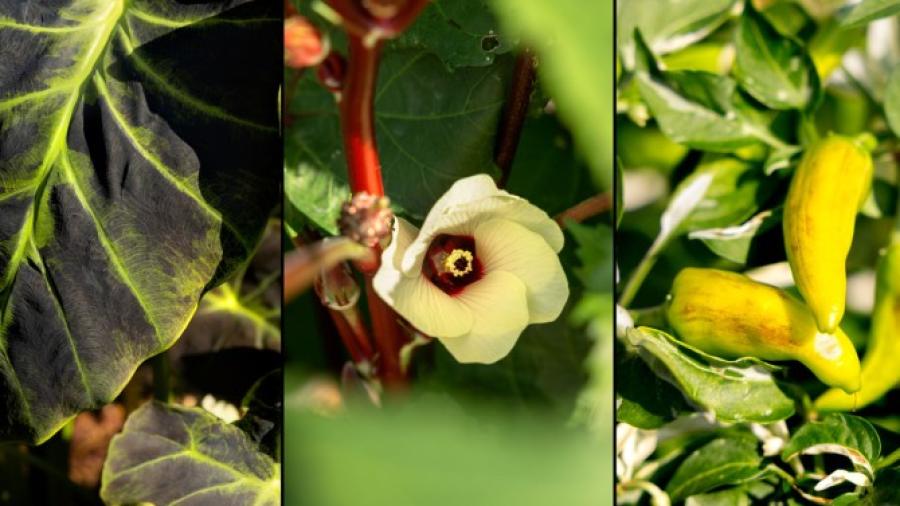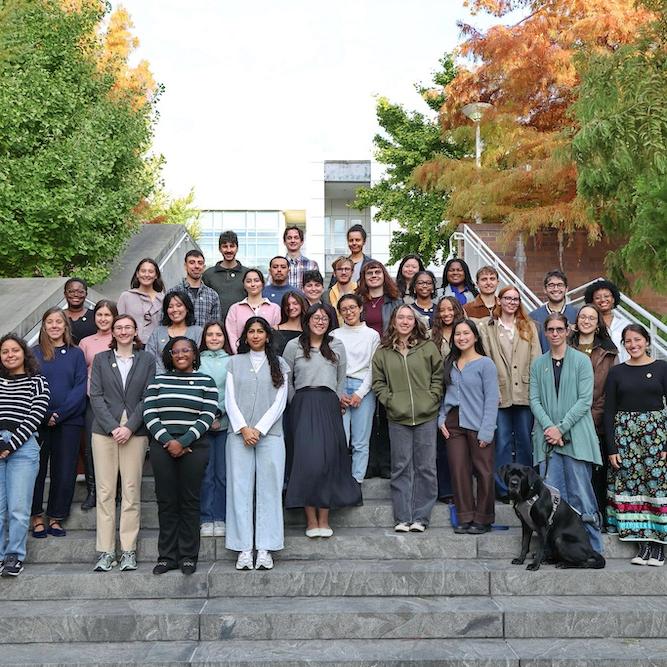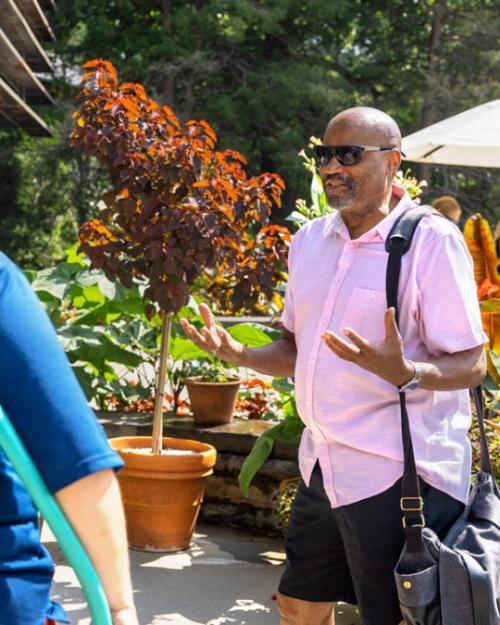Plain grits, made by his aunt and grandmother, were the only thing Kofi Acree would eat as a baby. Now he makes grits for himself in all sorts of ways – with shrimp and tomato sauce, with cheese and eggs.
Foods like grits, made from corn, offer a connection to the plants enslaved people of African descent used to survive and thrive, Acree says.
“The fact that I’m carrying on something that my ancestors did is something really wonderful. It’s a joy,” says Acree, director of the John Henrik Clarke Africana Library and curator of Africana Collections in Cornell University Library.
Corn is among the 21 plants featured in “Seeds of Survival and Celebration: Plants and the Black Experience” at the Cornell Botanic Gardens’ Nevin Welcome Center. The exhibition includes an outdoor plant display, audio tour and an indoor exhibit, all describing plants that are significant to the Black experience in the Americas dating back to the transatlantic slave trade. Acree served on the advisory committee that helped shaped the exhibition; he also curated an accompanying library guide.
“We look at that transatlantic slave trade – or ‘Maafa,’ the Swahili term meaning ‘Great Disaster’ – as something horrible,” Acree says. “But what the exhibit is really showing, in a sense, is how we survived.”
Food plants and cash crops
The exhibition focuses on food plants native to West Africa, such as black-eyed peas, okra and millet, that were used as provisions on the slave ships and became embedded in American cuisine. It also highlights the cash crops, like sugarcane, cotton and tobacco, that fueled the transatlantic slave trade.
The goal of the exhibit is to not only elevate the plants that are significant to the Black experience but also to offer a space of diversity and inclusion, says Sarah Fiorello, interpretation coordinator at the gardens. “These are really amazing stories, and enslaved Africans and their descendants are often not given credit for them in our country,” she says.
The seeds of leftover slave ship provisions – such as watermelon and sorghum – made their way to the gardens enslaved Africans planted around their living quarters. Their agricultural skill and resilience enabled them and their descendants to stay alive – and retain some of their dietary preferences and cultural identities under the trauma of kidnapping and enslavement, Acree says.
“What they did was amazing. They had to till these gardens after they worked, after they labored – for free, by the way,” Acree says. “And so that meant late at night, early in the morning, before they went to the fields.”
Collards were among several leafy green vegetables enslaved people grew in their own gardens, enabling them to carry on a West African tradition of incorporating leafy greens into soups and stews.
Collards hold a special place in the memories of Jakara Zellner ’23, co-leader on the Garden Ambassador team, who served on the advisory committee and narrated the audio tour.
Her mother cooked fresh collard greens from scratch for Sunday dinners and holidays. Zellner prepped the greens for her mother to cook, repeatedly washing the grit off of the tough leaves before her mother braised them, creating a savory “juice.”
“My mom also grew up near Mobile, Alabama, where her mother and grandmother farmed and we would often return home from visiting them with mason jars full of greens that they grew and prepared for us,” says Zellner, who is majoring in sociology and minoring in health equity. “Whenever I cook or eat collard greens now, I am reminded of these family memories.”
Okra, a member of the marshmallow family, had been used in African cooking for millennia; enslaved cooks introduced it into American foodways. Culinary historian Michael Twitty believes that fish peppers were first brought to Baltimore, Maryland by Haitians in the late 1800’s and soon after appeared in area gardens, kitchens and produce markets, grown almost exclusively by Black farmers. Taro’s large heart-shaped leaves are cooked into a spicy side dish known as callaloo that honors the legacy of African Caribbean ancestors.
“It’s an interesting culinary journey, to start to think more deeply about how these came to be,” Fiorello says, “and how great the contribution was by enslaved Africans and their descendants to creating these cuisines.”
The exhibition also includes the cash crops that enslaved people were forced to grow. West African rice farmers were specifically targeted for enslavement because of their expertise in rice cultivation. Between the 1740s and the 1770s, indigo was a significant commercial crop grown on Southern plantations, where enslaved people planted, cultivated, harvested and processed it to dye clothing worn by upper-class Europeans.
During the 1700s, the number of enslaved people in the Chesapeake Bay area and North Carolina increased from 10,000 to 1 million due to the increased European demand for tobacco, which led to a higher demand for labor.
Collaboration, contributions
The Cornell Botanic Gardens began work on the exhibit in fall 2021 by collaborating with Valerie Aymer, associate professor of practice, landscape architecture, in the College of Architecture, Art and Planning (AAP), and students enrolled in her Individual Study in Landscape Architecture class. The eight students conducted research on significant plants, with help from Acree’s library resources, and developed design concepts for the planting display. From these initial concepts, gardens’ horticulturists Melissa Cox and Emily Detrick determined which plants could be grown; Fiorello and educator Pam Shade conducted deeper research into the history of the plants. The advisory committee gave input to students through fall 2021 and to Gardens’ staff through spring 2022.
The advisory committee included Acree, Aymer, Fiorello, Zellner and Greg Page, emeritus professor of art, AAP; and Catherine Thrasher-Carroll, mental health promotion program director, Cornell Health.
The collaboration among students, staff and the advisory committee shaped the theme of the exhibit, which showcases how historically, these plants were important for survival.
The exhibition especially aims to uncover narratives about the many ways African descendants have contributed to American foodways and farming practices, Zellner says.
“I hope visitors interacting with these plants leave the gardens recognizing and acknowledging some of the innovative agricultural creations and techniques developed by Black Americans,” she says, “and how this history connects to current cultural cuisines and injustice within our food system.”
The garden installation is open dawn to dusk; the exhibit in the Nevin Welcome Center is open 10 a.m.-5 p.m. Tuesdays through Sundays.






